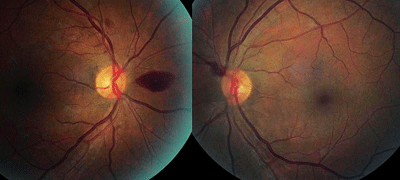 History
History
A 36-year-old white female presented to the office for a consult following her admission to the hospital for drug-dependency. The neurology team had interpreted some brain abnormalities when reviewing her magnetic resonance imaging (MRI) scans and asked us to rule out the possibility of embolic disease.
Although the patient exhibited signs of confusion and mental abnormality, she had no visual complaints, history of ophthalmic disease, or evidence of ocular trauma or surgery. Her systemic history was significant for substance abuse (both cocaine and heroin). She denied using any prescribed medications and reported no known allergies.
Diagnostic Data
Her entering visual acuity was 20/30 O.U. at distance and near, which was correctable to 20/20 O.U. with -1.00D sphere. Her pupils were equally round and reactive to light, with no afferent defect.
Extraocular muscle movements were full O.U. Confrontation fields revealed a right homonymous inferior quadrantanopia that was consistent with her brain injury on MRI testing.
Slit lamp examination showed normal anterior segment structures and chambers. Her intraocular pressure measured 18mm Hg O.U. The significant fundus finding is illustrated in the photograph.
Your Diagnosis
How would you approach this case? Does this patient require any additional tests? What is your diagnosis? How would you manage this patient? What’s the likely prognosis?
Discussion

Fundus images of our 36-year-old patient who was referred by the neurology department (O.D. left, O.S right). What do you notice?
Additional tests included automated visual fields, brightness testing and color testing (with specific intent to rule out red desaturation). We also obtained photodocumentation of her posterior poles.
The diagnosis in this case is systemic vasculopathy with a Roth-type hemorrhage (Roth spot). This finding confirms the presence of embolic disease, which was most likely caused by infectious bacterial endocardidtis. We returned the consult to the neurology department with a note indicating that we found evidence of potential embolic disease and suggested that a cardiologist be added to the management team.
Roth spots are defined as white-centered intraretinal hemorrhages.1-7 They are most frequently associated with leukemia, septic choreoretinitis secondary to bacterial endocarditis, and vascular changes seen within the capillaries of patients with diabetes.1,2,6,7 Other less common associations include anemia, sickle cell disease, myologenous leukemia, lupus and collagen vascular disease.1,8
Endocarditis is defined by a proliferative and exudative inflammation of the pericardium that surrounds the heart.3 It is characterized by the presence of vegetative deposits on the surface of the endocardium, within the endocardium or involving a heart valve.3,6,7 It mat also affect the inner aspects of the cardiac chambers.3
Endocarditis may occur as a primary idiopathic disease or in association with another concurrent disease.3 It is a common complication in Staphylococcus aureus bacteremia.4 One study compared the risk factors, clinical manifestations and outcome in a large, prospective cohort of 430 patients with S. aureus endocarditis in injection drug users (IDUs) and non-addicts.4 The researcher found that endocarditis was substantially more common among IDUs (46%) than non-addicts (14%).4 Also, IDUs were significantly younger, had fewer fatal underlying diseases or predisposing heart diseases, and their endocarditis was more often community-acquired than in non-addicts (95% vs. 39%, respectively).4
The annual incidence of infectious endocarditis in the United States is estimated to be seven cases per 100,000 individuals; this number continues to increase each year.5 The prognosis for the entity itself is influenced by timely diagnosis and adequate therapy.5 Antimicrobial therapy should be initiated only after quantitative sensitivity testing.5
Unfortunately, bacterial endocarditis has the capability to affect other organs. The prognosis of collateral, associated diseases will depend upon the haste with which they are discovered. Other factors that impact the prognosis are the ability to treat the afflicted organs/tissue and, in many cases, an accurate diagnosis of the underlying cause. As such, preventative measures that protect the body from further damage are not often enacted until some morbidity has occurred.
Because the patient had come to us from the emergency department, the final outcome of her overall condition is unknown.
1. Jarger EA, Jeffers JB, Tipperman R. Differential diagnosis of ocular signs. In: Rhee DJ, Pyfer MF. The Wills Eye Manual. Philadelphia: Lippincott, Williams and Wilkins; 1999:7-17.
2. Mandic BD, Potocnjak V, Bencic G, et al. Visual loss as initial presentation of chronic myelogenous leukemia. Coll Antropol. 2005;29 Suppl 1:141-3.
3. Friel JP. Endocarditis. In: Friel JP. Dorland’s Illustrated Medical Dictionary 26th ed. Philadelphia: WB Saunders Co; 1985:440.
4. Ruotsalainen E, Sammalkorpi K, Laine J, et al. Clinical manifestations and outcome in Staphylococcus aureus endocarditis among injection drug users and nonaddicts: a prospective study of 74 patients. BMC Infect Dis. 2006 Sep 11;6:137.
5. Horstkotte D, Piper C. New aspects of infective endocarditis. Minerva Cardioangiol. 2004;52(4):273-86.
6. Silverman ME, Upshaw CB Jr. Extracardiac manifestations of infective endocarditis and their historical descriptions. Am J Cardiol. 2007 Dec 15;100(12):1802-7.
7. Streicher T, Spirková J, Vican J. Retinitis septica Roth––a case report. Cesk Slov Oftalmol. 2011 Oct;67(4):140-2.
8. Kapadia RK, Steeves JH. Roth spots in chronic myelogenous leukemia. CMAJ. 2011 Dec 13;183(18):E1352.

